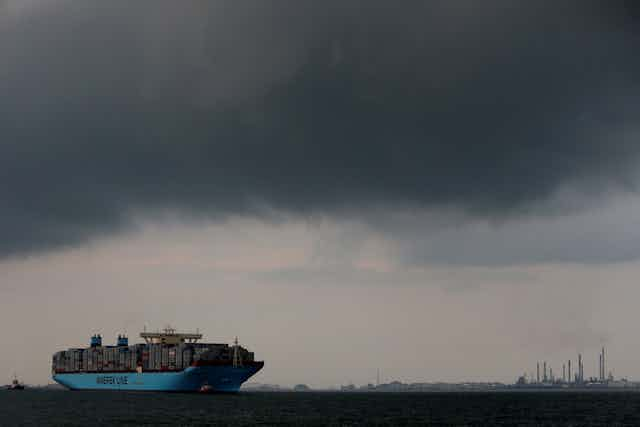Unease surrounding the fate of the global shipping industry has skyrocketed after the recent collapse of South Korean company Hanjin Shipping, the seventh-largest shipping line in the world. Maritime transport carries 90% of the world’s goods and is vital for global trade and economic prosperity, yet there are many signs pointing to the industry’s looming decline.
As an island nation, Australia relies on shipping to import and export nearly all goods and products. Any downswing in the global shipping environment will cause a hike in living costs.
The Global Shippers Forum, a trade association for shippers, warns that less competition between lines will increase shipping rates. This could drive up the price of imported goods on our shelves and make our exports less competitive in the global market.
Not only are there concerns about the impact of the demise of Hanjin, but there are rumours that more shipping companies are in trouble. Ratings agency Fitch is expecting more defaults among shipping lines, with very few assets easily convertible to cash and limited access to bank funding.
The Australian shipping industry has suffered a similar, albeit much smaller blow with the demise of Great Southern Shipping, a Chinese-owned company which only recently started up a new service between Australia and China. Due to a legal dispute, one of its ships carrying valuable cargo destined for Australia is idling in waters off the Australian east coast, with no prospect of docking any time soon. Importers and freight forwarders are furious about the delay in receiving their cargo.
A number of factors have led to uncertainty in the industry. A slowing of world GDP growth has resulted in less containerised goods being transported around the globe, causing an oversupply of ships and downward pressure on freight rates.
In Australia, container growth has slowed from a healthy 7% per annum before the global financial crisis to a more modest 1 to 2% per annum in recent years, reflecting trends around the world. In an effort to minimise costs, shipping lines are building larger and more efficient container ships, aggravating the oversupply issue.
Fighting back against slowing growth
One response to the slowing of global growth and oversupply of ships has been to combine shipping companies. For example, Hamburg Süd, a large German shipping company established 140 years ago, has just been sold to Maersk Line, the largest shipping line in the world.
Faced with reduced margins, the industry has looked into introducing worker automation to reduce labour costs. Driverless trains already haul hundreds of thousands of tonnes of iron ore from Pilbara mines to port. Fully or semi-automated container terminals, where driverless equipment loads containers onto vessels, are becoming more common. Australian terminals are leading the world in the introduction of automated technology.
Rolls-Royce Marine, in conjunction with a number of Northern European universities, is researching unmanned ships, which will move around the globe monitored from central control rooms. Japanese shipping company Mitsui OSK is forming a “Smart Shipping Office”, which will develop technologies for safer ship operation, with the ultimate goal of autonomous sailing.
What about Australia?
Australia relies heavily on ships to export resources around the globe. Port Hedland in WA ships out more than 1 million tonnes of iron ore each day. Newcastle is home to the largest coal export port in the world.
Most consumer goods in Australia are imported from overseas. The consolidation of shipping lines means less competition in the market and the threat of increased prices for our exporters and importers.
A recently released report suggests a revamp of our national shipping policy and, more urgently, our coastal trading policy. Current federal government shipping policy is inadequate.
If the government fails to act, there will be further deterioration and more job losses in the shrinking Australian shipping industry. The government needs to provide the right regulatory framework and subsidies, as it does for road and rail transport, for Australian ships to be competitive.
The recent earthquake in New Zealand, which caused major road and rail blockages on the South Island, required ships to transport supplies. Potential extreme weather events in Australia, such as flooding, mean we need the same capabilities here.
Australia is an island nation. A viable shipping industry will provide both sea-going careers and shore-based jobs and is vital for our economic prosperity.
Countries around the world are implementing policies to protect their supply chains and shipping industries. China has become a prime example, protecting its global supply chains by reinvigorating the old “Silk Road” overland route and establishing a maritime equivalent.
The US, another major global player, also plans to establish more protectionist trade policies. President-elect Donald Trump has declared he will renegotiate trade agreements and review US coastal shipping policies.
Given our heavy reliance on shipping, Australia needs to follow in these countries’ footsteps and act now to ensure foreign shipping interests do not hold us to ransom.

